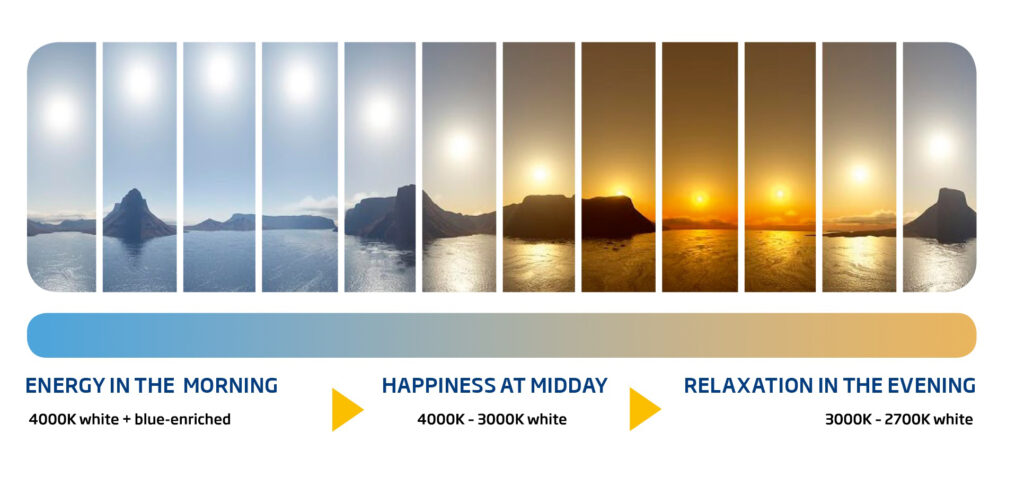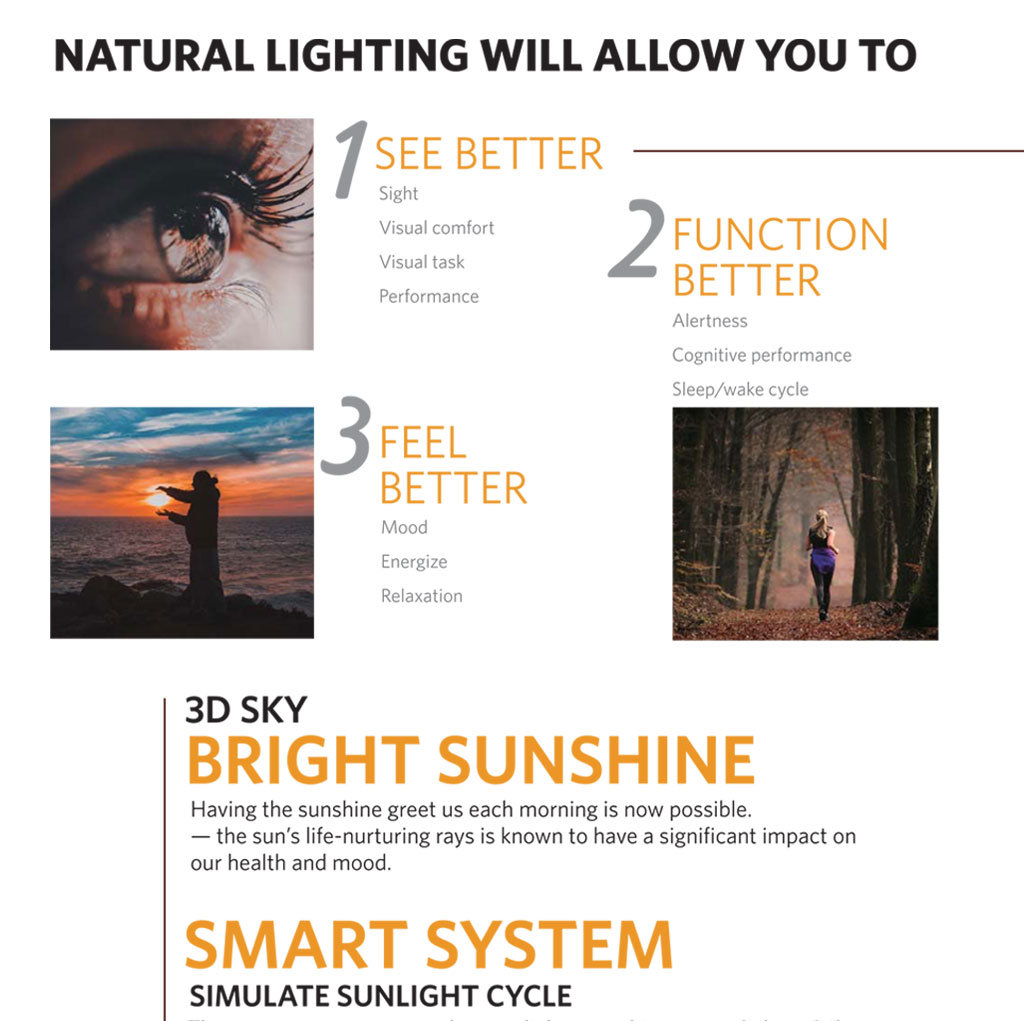Introduction:
Welcome to this blog, where we talk about how lightings impact our mood and productivity. We believe that lighting isn’t just about brightness—it’s about creating the right atmosphere for every occasion. In this blog post, we’re diving deep into the fascinating world of lighting psychology. We’ll explore how different lighting choices can affect your emotions, energy levels, and overall well-being. Discover the secrets to optimizing your environment with the perfect lighting solutions.
1. The Science Behind Lighting

THE BASIC OF HOW LIGHTING IMPACTS OUR CIRCADIAN RHYTHMS AND BIOLOGICAL CLOCKS.
When we think about lighting, we often focus on its practical aspects: how bright a room is, whether it suits our aesthetic preferences, and how well it illuminates our surroundings. However, lighting is more than just a utility—it’s a powerful force that can influence our health, mood, and overall well-being. In this blog post, we’re delving into the fascinating science behind lighting to uncover how it impacts our circadian rhythms, biological clocks, and, ultimately, our lives.
1.The Circadian Rhythms: Our Internal Timekeepers
Our bodies are finely tuned to a 24-hour cycle known as the circadian rhythm. This internal clock governs various physiological processes, including sleep-wake cycles, hormone release, and even body temperature fluctuations. One of the primary drivers of our circadian rhythm is light—specifically, the presence or absence of natural light.
Light and the Sleep-Wake Cycle: Our bodies have evolved to respond to the natural progression of sunlight throughout the day. In the morning, exposure to bright, natural light signals to our brains that it’s time to wake up and be alert. Conversely, as evening approaches and light diminishes, our bodies produce melatonin—a hormone that promotes sleepiness—helping us wind down and prepare for rest.
In today’s modern world, with artificial lighting available around the clock, it’s crucial to manage our exposure to light, especially in the evening. The blue light emitted by electronic devices like smartphones and computers can disrupt our natural sleep-wake cycle by tricking our brains into thinking it’s still daytime. This can lead to difficulty falling asleep and poorer sleep quality.
Light and Hormonal Balance: Light not only influences our sleep patterns but also plays a pivotal role in regulating hormonal balance. Exposure to natural light during the day helps regulate the production of hormones like cortisol (which keeps us awake and alert) and serotonin (which affects mood and well-being). Conversely, darkness at night triggers the release of melatonin, facilitating restorative sleep.
2. Artificial Lighting and Circadian Disruption
The prevalence of artificial lighting, especially in the form of energy-efficient LED and fluorescent bulbs, has introduced a new challenge to our circadian rhythms. Many of these lighting sources emit a high proportion of blue light, which can disrupt our internal clocks if not managed appropriately.
How to Optimize Lighting for Your Circadian Rhythm
- Morning Exposure: Spend time outdoors in the morning to benefit from natural light, which helps set your internal clock for the day.
- Evening Wind-Down: In the evening, reduce exposure to blue light from screens. Consider using “warm” or low-intensity lighting in your home to signal your body that it’s time to prepare for sleep.
- Smart Lighting: Invest in smart lighting systems that can adjust the color temperature and intensity of light throughout the day to mimic natural sunlight patterns.

2) Creating a Relaxing Santuary with Warm Lighting


THE CALMING EFFECTS OF WARM AND SOFT LIGHTING IN SPACES LIKE BEDROOMS AND LIVING ROOMS.
Warm and soft lighting can significantly enhance the ambiance and mood in spaces like bedrooms and living rooms, creating a cozy and inviting atmosphere. Here’s an exploration of the calming effects of warm lighting and tips on choosing fixtures to achieve this effect:
Calming Effects of Warm Lighting:
- Relaxation: Warm lighting, often with hues like soft yellows, oranges, and reds, tends to promote relaxation. It mimics the warm, comforting glow of natural light during sunrise or sunset, which is known to have a calming effect on our minds.
- Reduced Stress: Warm lighting can help reduce stress levels by creating a soothing environment. This is especially important in bedrooms and living rooms, where people go to unwind after a long day.
- Enhanced Comfort: Soft and warm lighting makes spaces feel cozier and more inviting. It can help people feel more comfortable and at ease, which is particularly beneficial for creating an inviting living room or a restful bedroom.
- Improved Sleep: In the bedroom, warm lighting is ideal for promoting sleep. It doesn’t disrupt your circadian rhythms like cool, blue light can. Consider using warm lighting in bedside lamps for bedtime reading or winding down.
Tips for Choosing Warm Lighting Fixtures:
- Bulb Type: Warm-white LED bulbs with a color temperature of 2700K to 3000K that emits warm, soft light and is gentle on the eyes.
- Dimmability: Install dimmer switches for your fixtures, allowing you to adjust the light intensity to suit different activities and moods. This flexibility is crucial for creating a calming atmosphere.
- Layered Lighting: Combine different types of fixtures to create layered lighting. This includes ambient (general), task (focused), and accent (decorative) lighting. For warmth, focus on ambient and accent lighting with warm tones.
- Choose Warm Materials: Consider fixtures made of materials like wood, fabric, or paper that can diffuse and enhance the warm glow of the light source.
- Lampshades: Lampshades can make a big difference. Choose shades in warm colors or materials that allow warm light to pass through gently. This softens the overall lighting effect.
- Wall Sconces: Wall-mounted fixtures with warm-toned shades can create a cozy and intimate atmosphere in living rooms and bedrooms.
- Candles: Candles, whether real or LED, can add a touch of warmth and intimacy to your space. They emit a soft, flickering light that complements warm fixtures well.
- Smart Lighting: Consider smart lighting systems that allow you to adjust the color temperature and brightness of your lights through a mobile app or voice commands. This flexibility can help you fine-tune the lighting to your desired warmth.
- Fixture Placement: Carefully consider the placement of fixtures to ensure even distribution of warm light. Avoid harsh shadows and dark corners.
- Lighting Design: If possible, consult with a lighting designer or interior designer to create a lighting plan that aligns with your overall design goals and ensures the desired calming effect.
In summary, warm and soft lighting can transform your bedroom and living room into cozy and inviting spaces. By selecting the right fixtures and following these tips, you can create a soothing and calming atmosphere that enhances relaxation and comfort.
To be continued in our next blog... stay tuned
3. The benefits of task lighting for workspaces, kitchens, and reading areas.
4. How cooler lighting can improve focus and alertness in offices and study spaces.
5. Showcase the power of mood lighting for parties and gatherings.
6. Guide to selecting bulbs based on color temperature and brightness.
7. Explore the convenience and flexibility of smart lighting systems.


